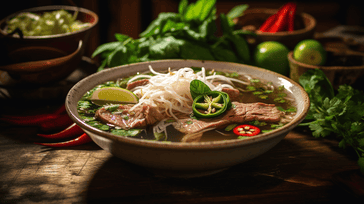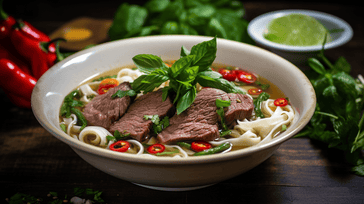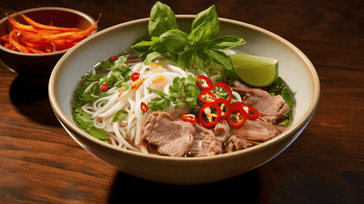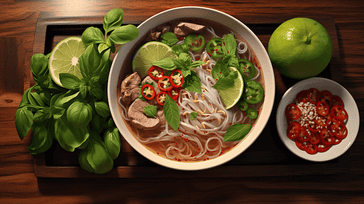- 28 June, 2025
- 53,848 Views

Are you looking for a truly heartwarming dining experience? Look no further than Vietnamese Pho, a delicious and authentic dish that has captured the hearts (and taste buds) of people around the world. Originating in Vietnam, pho is a culinary masterpiece that is known for its rich broth, tender meat, and flavorful herbs.
But what makes pho truly special is its ability to evoke a feeling of warmth and comfort with every slurp. Whether you're feeling under the weather or just craving a satisfying meal, pho is the perfect choice to lift your spirits and soothe your soul.
In this article, we'll explore the history and cultural significance of Vietnamese Pho, as well as the key elements that make up a perfect bowl of pho. We'll uncover the secrets of pho broth and the variety of toppings that can take your pho experience to the next level. Plus, we'll provide tips on finding a great pho restaurant near you and even share a step-by-step guide for making pho at home!
So come along with us on a journey through the world of Vietnamese Pho and discover why this heartwarming delight has become a true global favorite.
The History and Cultural Significance of Vietnamese Pho
If you're a fan of Vietnamese cuisine, chances are you've heard of pho. This traditional dish has become a popular staple around the world, known for its rich broth, tender meats, and flavorful herbs. But where did pho come from, and what makes it such an important part of Vietnamese culture? Let's take a look.
The Origins of Pho
The origins of pho can be traced back to the early 20th century, when French colonial influence was prevalent in Vietnam. During this time, French colonizers introduced beef to Vietnam, which led to the creation of bo kho, a beef stew dish that is still popular today. Over time, bo kho evolved into pho, which became a favorite street food among the Vietnamese people.
The Cultural Significance of Pho
Pho is more than just a dish - it's a symbol of Vietnamese culture. In Vietnam, pho is typically eaten for breakfast or lunch, and is considered a comforting and nourishing meal that can warm the soul. Pho is often served in casual settings, such as street vendors or small family-run restaurants, and is a popular choice for social gatherings.
Pho is also an important part of Vietnamese history. During the Vietnam War, pho became a staple food for soldiers and civilians alike. The dish was easy to make and provided much-needed sustenance in uncertain times. Today, pho has become a symbol of resilience and survival for the Vietnamese people.
Authentic pho is still made using traditional methods, such as simmering beef or chicken bones, spices, and herbs for hours to create a rich, flavorful broth. Pho is typically served with rice noodles, tender slices of meat, and a variety of herbs, such as basil and cilantro. The dish is often customized with condiments, such as chili sauce or hoisin sauce, to suit individual tastes.
Overall, pho is more than just a dish - it's a cultural icon that represents the resilience and warmth of the Vietnamese people. Whether you're enjoying a bowl of pho at a local restaurant or trying your hand at making it at home, you're experiencing a small piece of Vietnamese history and culture.
The Key Elements of a Perfect Bowl of Pho

If you have ever tasted an authentic bowl of Vietnamese pho, you know that its flavor and aroma are unmatched. But what goes into making a perfect bowl of pho? Here are the essential ingredients that contribute to the unique taste and heartwarming qualities of this beloved dish:
| Key Ingredient | Description |
|---|---|
| Rich Broth | The broth is the foundation of pho and is typically made by simmering beef or chicken bones for hours to extract their savory flavors. It is seasoned with a blend of spices, including star anise, cinnamon, and cloves, to create a fragrant aroma. |
| Flavorful Herbs | Fresh herbs like Thai basil, cilantro, and sawtooth herb are commonly served with pho, adding a pop of color and a burst of flavor. They also provide a refreshing and cleansing effect on the palate. |
| Tender Meat | Thin slices of rare beef, cooked brisket, or meatballs are common choices for pho. The meat is often added raw to the hot broth, cooking and absorbing the flavors as the dish is served. |
| Pho Noodles | Flat rice noodles are the traditional choice for pho, offering a chewy texture that complements the broth and meat. The noodles are typically cooked separately before being added to the broth. |
| Pho Toppings | Popular toppings include bean sprouts, lime wedges, jalapeno slices, and hoisin sauce. These ingredients add texture, freshness, and a touch of sweetness to the dish. |
Of course, different pho restaurants and regions may have their own variations or unique ingredients, but these key elements are what make up the classic flavor profile of pho. With a little bit of experimentation and a lot of love, you can make your own perfect bowl of pho right at home!
Unraveling the Secrets of Pho Broth
Pho broth is the soul of the dish, providing rich and savory flavors that make it so delicious. Making the perfect pho broth is no easy task, as it requires careful attention and a lengthy simmering process to extract the flavors from the ingredients.
The traditional method of making pho broth involves simmering beef bones for several hours, sometimes even up to 12 hours, along with onions, ginger, cloves, and other aromatic spices. The slow cooking process allows the flavors to develop and intensify, resulting in a deeply flavorful broth that is the heart of a good pho.
The type of bones used can also affect the flavor of the broth. Beef knuckle bones or oxtail bones are commonly used, as they contain a lot of collagen that lends a rich and gelatinous texture to the broth. Some recipes also call for adding chicken or pork bones for added depth of flavor.
Another key to achieving a flavorful pho broth is skimming off any impurities that may rise to the surface during the simmering process. This helps the broth to stay clear and prevents any bitter or off flavors from developing.
Once the broth is ready, it can be seasoned with fish sauce or soy sauce to enhance the umami flavors, as well as salt to taste. The result is a deep, satisfying broth that makes a perfect complement to the noodles and toppings in pho.
Exploring the World of Pho Noodles

One of the most important components of a delicious bowl of pho is the noodles. Authentic Vietnamese pho typically uses thin, flat rice noodles, but there are a variety of other noodle options available to suit different tastes and preferences.
The texture of the noodles is key to achieving the perfect bowl of pho. They should be tender, but not mushy, with a slight chewiness to them. To achieve this texture, it's important to cook the noodles just right and rinse them thoroughly afterwards to remove excess starch.
Here are some of the most common types of noodles used in pho:
| Noodle Type | Description |
|---|---|
| Thin Rice Noodles | The traditional choice for pho, these noodles are made from rice flour and water. They are soft and delicate, with a slightly slippery texture. |
| Wide Rice Noodles | These noodles are wider and flatter than thin rice noodles, giving them a chewier texture. They are often used in dishes like pad see ew. |
| Egg Noodles | Made with wheat flour and egg, these noodles have a yellow hue and a slightly firmer texture. They are commonly used in Chinese noodle soups. |
Experimenting with different noodle types can add an interesting twist to your pho experience. If you're feeling adventurous, try using udon noodles, soba noodles, or even spaghetti!
Choosing the Right Noodle Width
The width of the noodle can also affect the overall flavor and texture of the dish. Thin noodles are more delicate and allow the broth to shine through, while wider noodles absorb more of the broth and add a chewy texture.
It ultimately comes down to personal preference, but as a general rule of thumb, thin noodles work well with lighter broths, while wider noodles pair better with heartier broths.
Whichever noodle type and width you choose, make sure to cook them just right to achieve that perfect, satisfying bite in every spoonful of pho.
Elevating Your Pho Experience with Toppings
While pho is delicious on its own, toppings can take it to the next level.
The most common toppings include:
| Topping | Description |
|---|---|
| Bean Sprouts | Crunchy and fresh, they add texture and flavor. |
| Basil | The herb's natural sweetness complements the savory broth and meat. |
| Lime | The citrusy tang adds a burst of freshness to the soup. |
| Jalapenos | For those who like it spicy, these peppers add a kick. |
For a more adventurous experience, try adding:
- Scallions
- Cilantro
- Sriracha sauce
- Hoisin sauce
- Fried garlic
Remember, the toppings are traditionally served on the side and added to the broth at the diner's discretion.
Experiment with different combinations and discover your own favorite pho topping medley!
Finding the Best Pho Restaurant Near You

If you're craving an authentic bowl of Vietnamese pho, the first step is to find a restaurant that delivers the real deal. With so many options out there, it can be overwhelming to choose the right one. Here are some tips to help you find the best pho restaurant near you:
- Read reviews: Look up reviews of different pho restaurants in your area on sites like Yelp or Google. Pay attention to overall ratings as well as specific comments about the taste and authenticity of the pho.
- Check the menu: Look for restaurants that offer a variety of pho options beyond just beef or chicken, such as pork, seafood, or vegetarian options. A diverse menu can indicate a greater level of authenticity and experience in preparing pho.
- Consider ambiance: While the taste of the pho is the most important factor, the ambiance of the restaurant can also contribute to your overall experience. Look for places that have a cozy and inviting atmosphere, with decor that reflects Vietnamese culture.
- Ask for recommendations: If you have any Vietnamese friends or acquaintances, ask them for their favorite pho spots. They may have insider knowledge on lesser-known but highly authentic restaurants in your area.
By following these tips, you'll be well on your way to finding a pho restaurant that delivers a truly authentic and satisfying pho experience.
Cooking Pho at Home: A Step-by-Step Guide
If you're craving a warm bowl of pho but can't make it to your favorite Vietnamese restaurant, why not try making it at home? With a few simple ingredients and some patience, you can enjoy a delicious bowl of homemade pho in no time. Follow these steps to get started.
Ingredients:
For the broth:
- 2-3 pounds of beef bones
- 1 onion, sliced in half
- 3-4 inches of ginger, sliced in half
- 5-6 cloves of garlic, crushed
- 2-3 star anise
- 1 cinnamon stick
- 2-3 tablespoons of fish sauce
- Salt and sugar to taste
For the pho:
- 1 pound of rice noodles
- 1-2 pounds of beef, sliced thinly
- 1 onion, sliced thinly
- 2-3 green onions, chopped
- A handful of fresh cilantro
- A handful of fresh basil
- Bean sprouts and lime wedges for serving
Instructions:
- In a large pot, add beef bones and cover with water. Bring to a boil and let simmer for 10-15 minutes. Drain and rinse the bones with cold water. This step removes any impurities and helps achieve a clear broth.
- Return the bones to the pot and add onion, ginger, garlic, star anise, and cinnamon stick. Cover with water and bring to a boil. Reduce heat and let simmer for at least 6 hours, or up to 12 hours for a richer flavor.
- Remove the bones and strain the broth through a fine mesh strainer. Discard the solids.
- Season the broth with fish sauce, salt, and sugar to taste. Keep warm on low heat.
- Cook the rice noodles according to package instructions. Drain and rinse with cold water.
- Fill a large bowl with rice noodles and top with thinly sliced beef.
- Ladle hot broth over the beef and noodles. The heat from the broth will cook the beef.
- Garnish with sliced onions, green onions, cilantro, basil, and bean sprouts. Serve with lime wedges on the side.
Now that you have the basic recipe down, feel free to experiment with different ingredients and toppings. Add some sliced chili peppers for extra heat, or try using chicken or tofu instead of beef for a vegetarian option. The possibilities are endless!
Enjoy your homemade pho and impress your friends and family with your newfound cooking skills.
Pho Variations: Exploring Regional Differences
While pho is a beloved dish throughout Vietnam, there are regional variations that make it all the more interesting to explore. Here are some of the most notable:
| Region | Variation | Description |
|---|---|---|
| Hanoi | Pho Bac | This variation is said to be the original style of pho and is typically made with a light, clear broth and thin slices of beef. It's served with fresh herbs and lime wedges on the side. |
| Saigon | Pho Nam | Also known as Southern-style pho, this version features a sweeter, heartier broth, often made with more spices and seasonings. It also tends to have a wider variety of meats, including beef, pork, and chicken. |
| Hue | Bun Bo Hue | While technically not pho, this noodle soup is a close relative and popular in the central region. It features a spicy, lemongrass-infused broth and contains a variety of meats, including beef, pork, and sausage. |
Other variations include pho with seafood, vegetarian pho, and regional versions with unique ingredients or preparation methods. Exploring these variations can be a fun and delicious way to discover the diversity of Vietnamese cuisine.
Pho: A Healthy and Nutritious Choice
Not only is Vietnamese Pho a delicious and flavorful dish, but it is also a healthy and nutritious option for those looking to maintain a balanced diet. The broth-based soup is packed with nutrients and low in calories, making it a popular choice among health-conscious individuals.
The key ingredients of pho contribute to its nutritional value. The broth, which is the heart of the dish, contains essential nutrients such as collagen, minerals, and amino acids, promoting healthy skin, bones, and muscles. The herbs and spices used in pho, such as cinnamon and star anise, have anti-inflammatory properties and can help boost the immune system.
Pho also often includes lean cuts of beef or chicken, providing a good source of protein while remaining low in fat. The addition of fresh vegetables, such as bean sprouts and cilantro, adds fiber and vitamins to the dish, contributing to a well-rounded meal.
Thanks to its nutrient-rich ingredients, pho is a satisfying and filling option that won't leave you feeling weighed down. Plus, its low-calorie nature makes it a great choice for those looking to control their calorie intake without sacrificing flavor.
So the next time you're looking for a healthy and delicious meal, consider trying authentic Vietnamese Pho. Your taste buds and your body will thank you!
Frequently Asked Questions about Vietnamese Pho
Vietnamese pho is a delicious and popular dish that has gained popularity all over the world. However, you may still have some questions about this flavorful soup. Here are some of the most frequently asked questions about Vietnamese pho:
What is pho made of?
Pho is typically made with a flavorful broth that has been simmered for hours with beef bones, charred ginger, onions, cinnamon, and star anise. The broth is then poured over rice noodles, which are topped with beef or chicken and a variety of fresh ingredients like bean sprouts, scallions, and cilantro.
How healthy is pho?
Pho is a relatively healthy soup, as it contains plenty of nutrient-rich ingredients like herbs, spices, vegetables, and protein. Additionally, pho is quite low in calories, making it a great option for those seeking a nutritious and satisfying meal.
Can I make pho at home?
Yes! Making pho at home is easier than you might think. While it does take some time to simmer the broth and prepare the ingredients, the end result is well worth the effort. Check out our step-by-step guide on how to make pho at home in Section 8.
Is all pho the same?
No, pho can vary depending on the region of Vietnam it comes from and the specific ingredients used. Some variations include pho ga, a chicken-based soup, and pho chay, a vegetarian version that uses mushrooms and tofu instead of meat.
What's the best way to enjoy pho?
The best way to enjoy pho is to customize it to your liking. Add fresh herbs like basil and lime, or spicy sauce like sriracha, to give your soup a unique flavor profile. Don't be afraid to experiment with different toppings or try new variations of pho.
What is the best pho restaurant near me?
Finding the best pho restaurant in your area can be a bit of a trial-and-error process. Check out Section 7 for tips on how to find an authentic pho restaurant near you, and don't be afraid to ask for recommendations from friends or locals.
With these frequently asked questions about Vietnamese pho, you can confidently enjoy this delicious and heartwarming dish with a greater understanding of its history and preparation.
